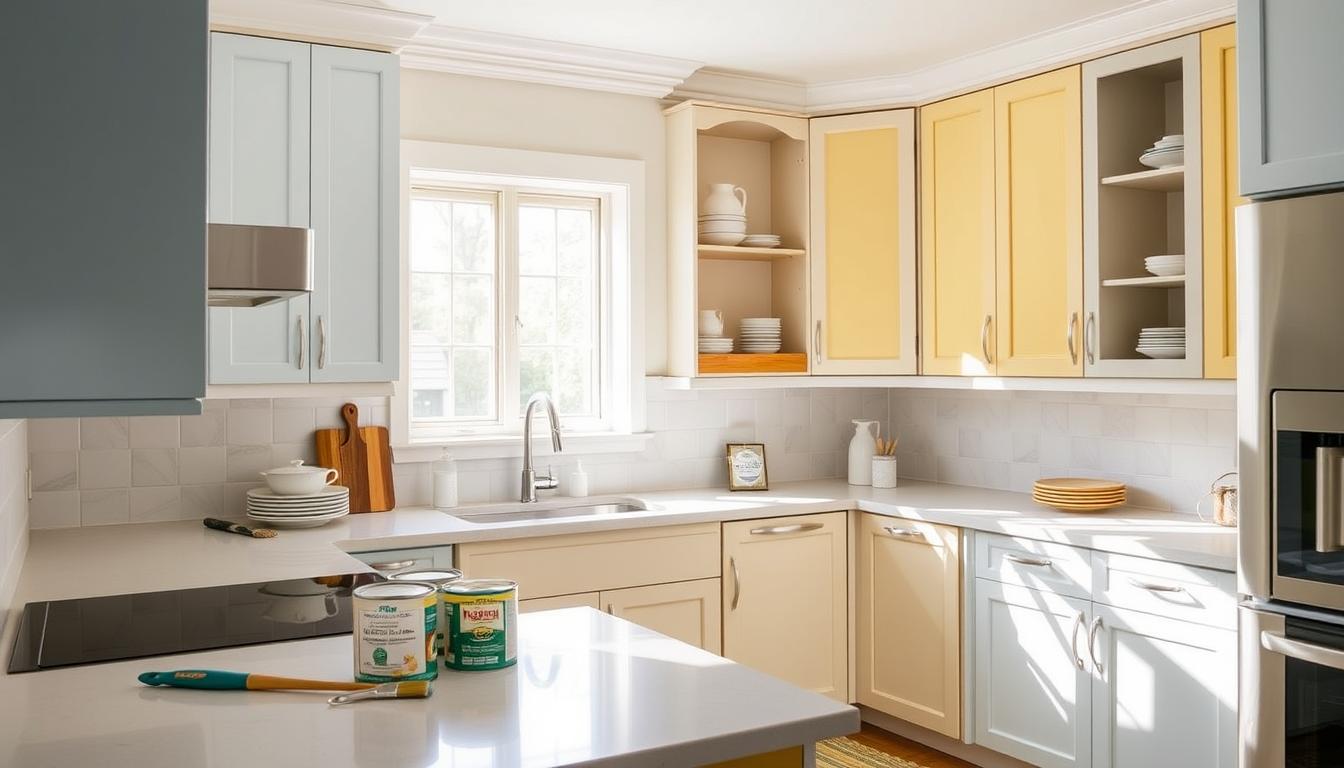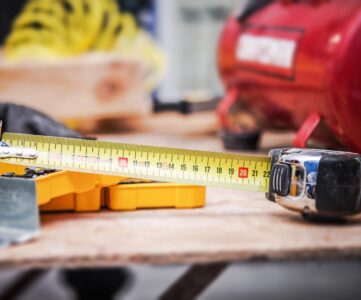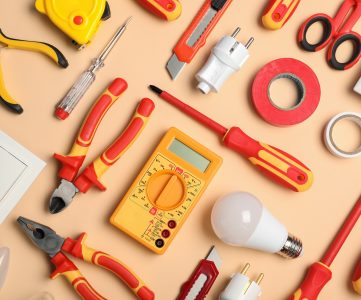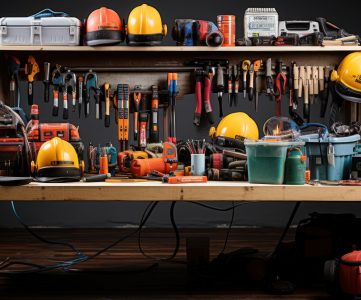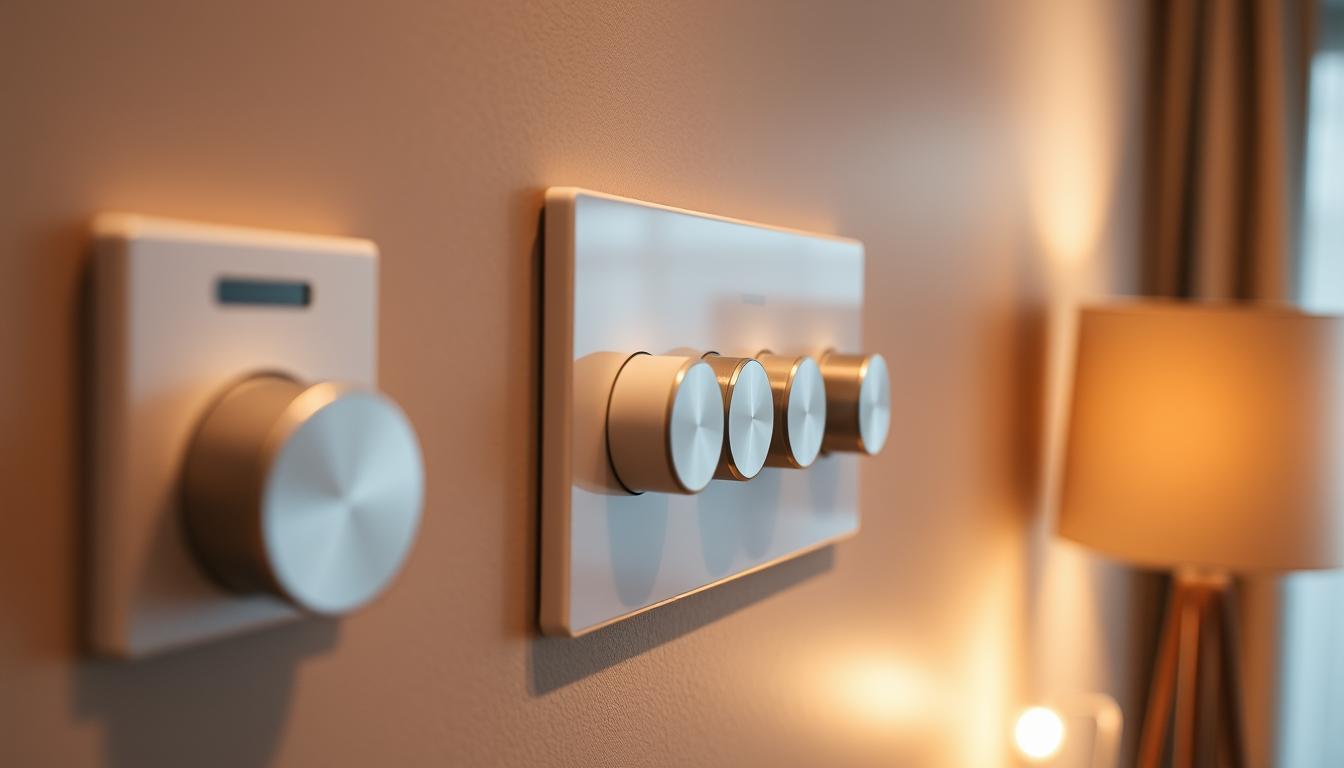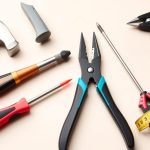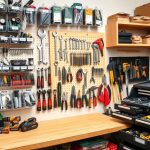Welcome to our comprehensive guide on cabinet painting, a cost-effective way to give your kitchen a fresh new look through cabinet refinishing. If you’re looking to update your kitchen without breaking the bank, you’re in the right place. With the right tools and techniques, you can achieve professional-looking results and complete a successful kitchen update.
A kitchen update can be achieved with cabinet painting, which is an efficient and budget-friendly method. This guide will walk you through the process, from preparation to finishing touches, to help you create the kitchen of your dreams through cabinet refinishing.
Our goal is to provide you with the necessary information to transform your kitchen into a beautiful and functional space. Whether you’re a DIY enthusiast or a homeowner looking to save money, this guide is for you. Cabinet painting is a great way to update your kitchen and give it a fresh new look.
Introduction to Cabinet Painting
Cabinet painting is a popular method for kitchen update, and it’s easy to see why. It’s a cost-effective way to transform your kitchen and give it a fresh new look. With the right tools and techniques, you can achieve professional-looking results and complete a successful cabinet refinishing project.
Key Takeaways
- Cabinet painting is a cost-effective way to update your kitchen
- Cabinet refinishing can give your kitchen a fresh new look
- With the right tools and techniques, you can achieve professional-looking results
- A kitchen update can be achieved with cabinet painting
- Cabinet painting is a budget-friendly method for transforming your kitchen
- Cabinet refinishing is a great way to save money and update your kitchen
Why Cabinet Paint Can Revolutionize Your Kitchen
Cabinet painting is a transformative option for homeowners aiming to refresh their kitchen without financial strain. Opting for kitchen painting instead of cabinet replacement can save homeowners thousands. It also streamlines the process through efficient cabinet prep.
When planning a kitchen makeover, it’s crucial to evaluate the costs and advantages of various methods. Here are some key considerations:
- Cost savings: kitchen painting can be up to 50% cheaper than replacing cabinets
- Environmental benefits: refinishing cabinets reduces waste and minimizes the environmental footprint of the project
- Time investment: cabinet prep and painting can be completed in a fraction of the time it takes to replace cabinets
Kitchen painting also opens up a world of design possibilities. With an array of colors and finishes available, homeowners can craft a unique space that mirrors their personal taste.
Choosing cabinet prep and painting allows homeowners to achieve a luxurious look without the hefty price tag. This method is ideal for those seeking to revamp their kitchen economically. It’s also a great way to cut down on waste and environmental impact.
| Option | Cost | Environmental Impact |
|---|---|---|
| Replace Cabinets | High | High |
| Kitchen Painting | Low | Low |
Essential Tools and Materials for Cabinet Painting
To succeed in cabinet painting, having the right tools and materials is key. Understanding paint adhesion is crucial for a lasting finish. A strong paint adhesion prevents peeling and flaking. Cabinet spraying offers a smooth finish, making it a popular choice.
Here’s a list of must-haves for your project:
- Sandpaper and primer for preparing the surface
- Paint and a paint sprayer for application
- Drop cloths and protective gear for safety
- A clean and well-ventilated workspace
Proper surface preparation is vital for good paint adhesion. Clean and degrease the surface, then sand for a smooth finish. With the right tools and knowledge of paint adhesion and spraying, your cabinet painting project will be a success.
Investing in quality tools and materials saves time and effort. Always follow safety guidelines and manufacturer instructions when using paint and materials.
| Tool/Material | Purpose |
|---|---|
| Sandpaper | Surface preparation |
| Primer | Improving paint adhesion |
| Paint sprayer | Even and smooth application |
Preparing Your Kitchen for the Transformation
A successful kitchen update starts with thorough preparation. Before painting your cabinets, clear and protect your space. Remove cabinet doors and hardware, and set up a suitable workspace. This ensures a smooth and efficient cabinet prep process.
Here are the key steps to prepare your kitchen:
- Clear everything from your countertops and floors to prevent damage and make cleaning easier.
- Cover your floors, countertops, and appliances with drop cloths or plastic sheets to protect them from paint spills and splatters.
- Remove cabinet doors and hardware to prevent paint from getting on them and to make it easier to paint the cabinets.
By following these steps, you’ll create a safe and efficient workspace for your kitchen update project. Remember to take your time and be thorough in your cabinet prep to ensure a successful transformation.
The Critical Steps of Cabinet Surface Preparation
In cabinet refinishing, a well-prepared surface is key for a lasting paint job. This step ensures the paint sticks well and the finish is even. Proper preparation greatly affects paint durability, making it crucial in the refinishing process.
To get a smooth finish, start with a clean surface. Clean and degrease the cabinets to remove grease, grime, or dirt. Regular cleaning products work well, but always follow the instructions to avoid damage.
Cleaning and Degreasing Techniques
- Use a mixture of soap and water to clean the surface
- Apply a degreaser to remove any stubborn stains or grime
- Rinse the surface thoroughly with clean water
After cleaning and degreasing, sand the surface. This step creates a smooth finish and ensures paint adhesion. Sanding is vital in cabinet refinishing, affecting the finish quality and paint durability.
Sanding Methods and Guidelines
Sanding can be manual or with a power sander. Always follow the manufacturer’s instructions and take safety precautions to avoid injury.
By following these critical steps, you can achieve a successful cabinet refinishing project. Remember to always follow the manufacturer’s instructions and take necessary safety precautions to avoid injury.
Choosing the Right Cabinet Paint and Primers
When tackling cabinet painting, picking the right paint and primers is vital for success. Paint adhesion plays a crucial role, impacting both the finish’s durability and look. To ensure optimal adhesion, it’s key to select a primer tailored to your cabinet’s material.
A superior primer boosts paint adhesion and guarantees a flawless finish. For cabinet spraying, a top-notch primer is crucial, forming a robust bond between paint and cabinet. Various primers exist, including water-based, oil-based, and shellac-based, each offering unique benefits and characteristics.
When selecting paint and primer for your cabinet project, consider these factors:
- Type of cabinet material (wood, MDF, etc.)
- Desired finish (matte, glossy, etc.)
- Color and shade
- Primer compatibility
Investing time in choosing the right paint and primers ensures a professional finish that endures.
| Primer Type | Benefits | Drawbacks |
|---|---|---|
| Water-based | Eco-friendly, easy to clean up | May not provide adequate adhesion |
| Oil-based | Provides strong adhesion, durable finish | Strong odor, takes longer to dry |
| Shellac-based | Non-toxic, easy to apply | May not be suitable for all cabinet materials |
Professional Techniques for Cabinet Paint Application
Attaining a professional finish in kitchen painting necessitates both skill and knowledge. The application of paint to cabinets is a critical step. It requires meticulous attention and the right techniques to achieve a rewarding outcome.
The objective is to achieve a smooth, even finish that elevates your kitchen’s appearance. To accomplish this, you must consider the most effective paint application methods. These include brush, roller, and spray techniques. Each method has its own set of advantages and disadvantages, influenced by the cabinet type and desired finish.
Brush vs. Roller vs. Spray Methods
Brushes excel in handling intricate details and small areas. Rollers, on the other hand, are more suitable for larger surfaces. Spray methods offer a smooth finish but demand more preparation and expertise. Success hinges on selecting the appropriate tool and using it correctly.
Achieving Even Coverage
To ensure even coverage, applying thin, consistent paint coats is crucial. Each coat should dry before the next is applied. This process may require patience, but the result is well worth the effort. High-quality paint with superior durability also plays a key role in maintaining the finish over time.
| Method | Advantages | Disadvantages |
|---|---|---|
| Brush | Precise control, ideal for details | Time-consuming, may leave brush strokes |
| Roller | Fast coverage, smooth finish | May not be suitable for intricate areas |
| Spray | Smooth, even finish, fast application | Requires expertise, extensive preparation |
By mastering these professional techniques for cabinet paint application, you can achieve a beautiful, durable finish. This enhances your kitchen’s overall aesthetic. Remember, success depends on patience, attention to detail, and the right techniques for a lasting, professional-looking finish.
Common Mistakes to Avoid During Cabinet Painting
Even with meticulous planning, cabinet refinishing can go wrong if common mistakes are not avoided. Choosing the right paint and primer is critical. A poor selection can cause the finish to chip, fade, or peel.
Another mistake is using improper application techniques. This can lead to uneven coverage, streaks, or brush marks. Always follow the manufacturer’s instructions for the paint and primer you’re using.
Paint Selection Errors
- Choosing a paint that is not suitable for the cabinet material
- Not considering the color and finish of the surrounding decor
- Overlooking the importance of primer in ensuring a smooth finish
Application Missteps
To avoid application errors, prepare the surface well, use the right tools, and work in a well-ventilated area. It’s also key to let each coat dry fully before applying the next one.
Timing and Drying Issues
Timing is crucial in cabinet painting. Rushing can result in an uneven finish. By following the drying times recommended by the manufacturer, you’ll achieve a professional finish that lasts.
Finishing Touches and Reassembly
As you near the end of your kitchen update, it’s time to add the finishing touches and reassemble your space. This includes replacing hardware, touching up any mistakes, and applying a clear coat for added paint durability.
A well-planned kitchen update can make a significant difference in the overall look and feel of your home. To ensure your new kitchen is both functional and beautiful, consider the following steps:
- Replace hardware with new knobs or handles to give your cabinets a fresh look.
- Touch up any mistakes or areas where the paint may have gotten on surrounding surfaces.
- Apply a clear coat to protect your cabinets and ensure paint durability.
By following these steps, you’ll be able to enjoy your newly updated kitchen, complete with durable and long-lasting paint. Remember to take your time and be patient during the reassembly process, as it’s the final step in completing your kitchen update.
Maintaining Your Newly Painted Cabinets
To ensure your newly painted cabinets stay in top condition, regular upkeep is key. This involves cleaning, touch-ups, and long-term care. It’s vital to use proper cabinet spraying methods and ensure strong paint adhesion for a lasting finish.
A well-maintained cabinet boosts your kitchen’s look and safeguards your investment. Here are some essential tips for cabinet upkeep:
- Regularly clean your cabinets with a soft cloth and mild detergent to prevent dirt and grime buildup.
- Avoid using harsh chemicals or abrasive cleaners that can damage the paint or compromise paint adhesion.
- For tough stains or spills, gently scrub the area with a non-abrasive sponge and dry immediately to prevent water spots.
By adhering to these simple guidelines and employing the right techniques, like cabinet spraying, your cabinets will remain stunning for years. Always refer to the manufacturer’s guidelines for specific cleaning and maintenance advice. This ensures your cabinets last longer.
With the right care and maintenance, your newly painted cabinets will continue to be a beautiful and functional kitchen feature. They will provide a lasting impression and enhance your cooking experience.
Conclusion: Enjoying Your Transformed Kitchen Space
After completing the cabinet painting process, your kitchen has been transformed into a stunning, budget-friendly space. The heart of your home now exudes a renewed sense of style and vitality. Take a moment to admire your handiwork – the kitchen painting project has breathed new life into the area. It has become a welcoming and visually appealing gathering place for your family and guests.
Remember, the key to maintaining your cabinet refinishing results is diligent care and attention. Follow the cleaning guidelines and touch-up procedures outlined in the previous section. This will ensure your cabinets continue to look their best for years to come. With the right mindset and a little bit of elbow grease, you can keep your kitchen looking professionally polished without the high cost of a full remodel.
Now that the hard work is done, it’s time to sit back, relax, and enjoy your newly transformed kitchen. Gather your loved ones around the table, cook up delicious meals, and create lasting memories in your space. The investment you’ve made in kitchen painting has not only enhanced the aesthetics but also added value to your home. Embrace this newfound joy and take pride in your accomplishment.
